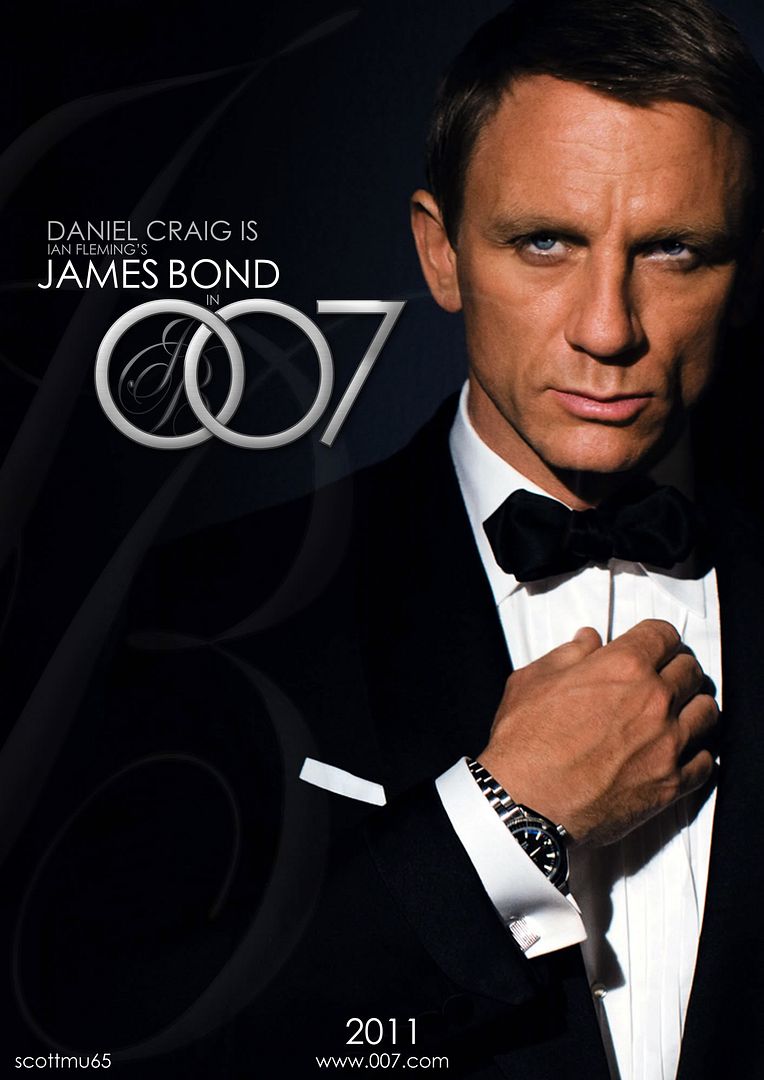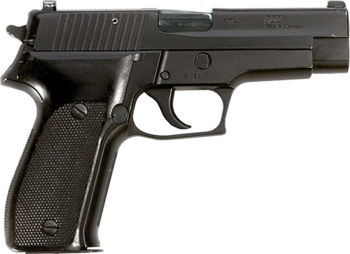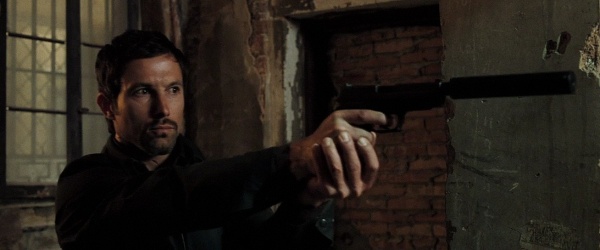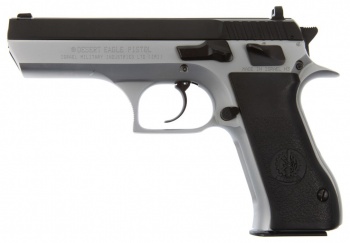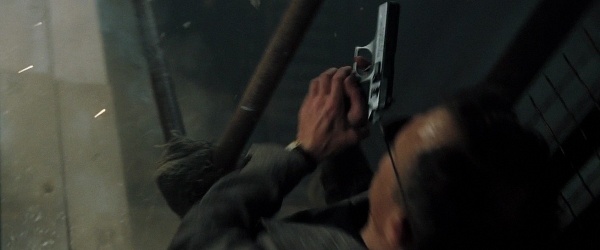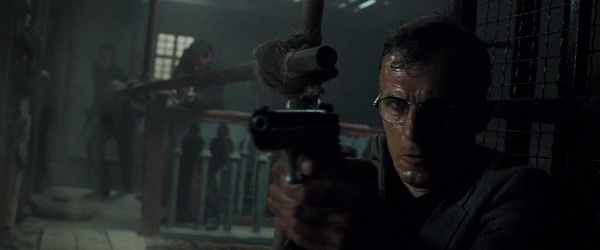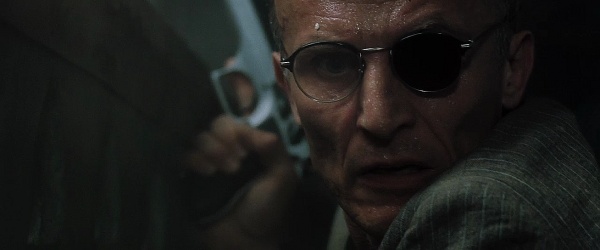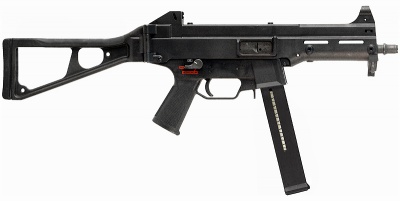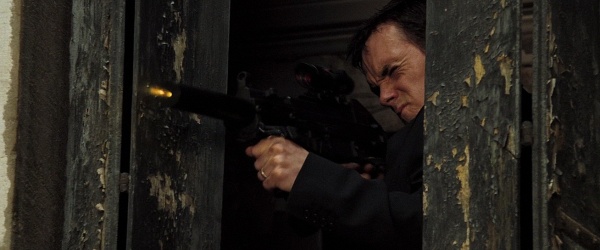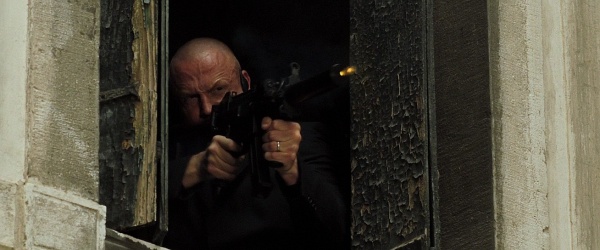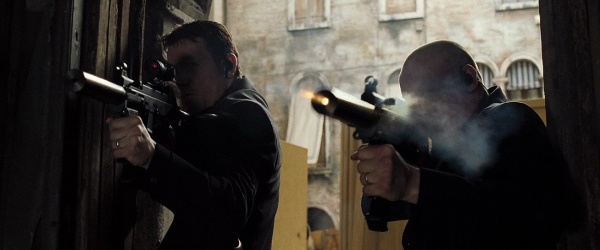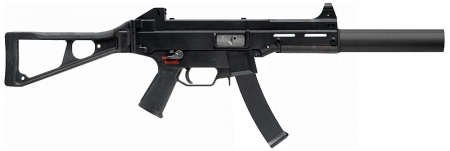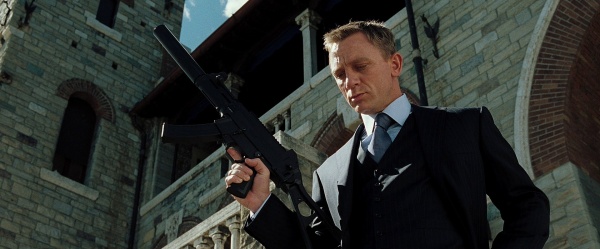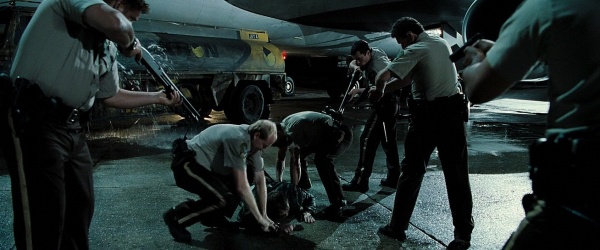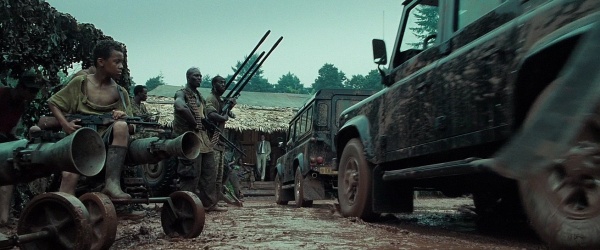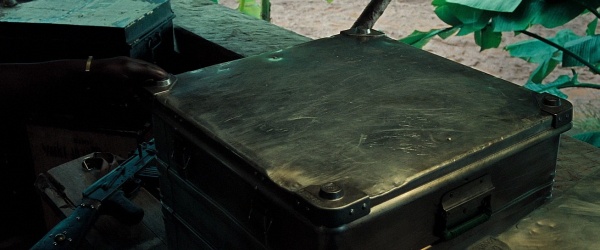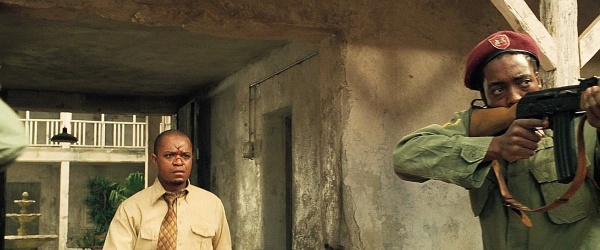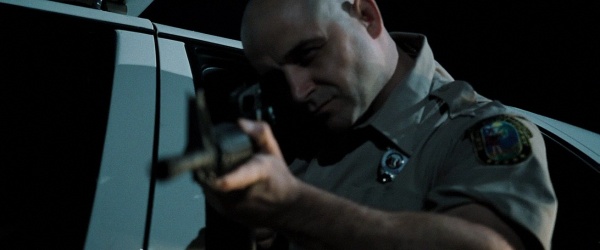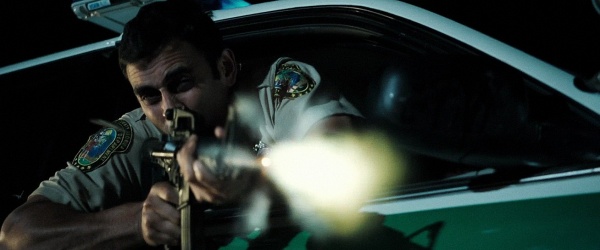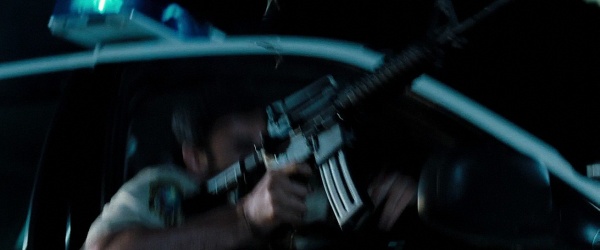| Menu |
Select a Name:
Daniel
Craig the sixth and latest actor to play the secret agent 007 is also the highest paid James Bond of all
time and is on track to be one of the highest-paid actors in the world.
For the
three James Bond films he has appeared in, Casino Royale, Quantum of Solace and
Skyfall he’s received over $27 million (£18 million).
But that’s
not all, it is also signed up to do the next two James Bond films for a massive
$47 million (£31 million).
Now you
would expect man who is earning that sort of money to be living the high life,
buying mansions around the world driving the latest and most expensive sports
cars. Maybe for some but not for Daniel Craig, he prefers to keep a low
profile. He’s been living in a low key apartment block in New York’s East
Village next to tattooed parlour.


Daniel
Craig – How much is he worth
Maybe you’d
expect the James Bond actor to be driving an Aston Martin but this 007 prefers
an Audi A6 saloon. That’s the sort of car you would see a sales executive
driving up and down the motorway in rather than a Hollywood A lister but again
it doesn’t attract attention.
But this is
the norm for the working class boy from the Wirral who grew up in a pub. He
much prefers a pint in the local pub to a vodka martini – shaken, not stirred
with the swanky celebrity set.
Up till
2006, Daniel Craig had been making a nice living in TV roles such as “Our friends
in the North” and films like Lara Croft : Tomb Raider, Road to Perdition, Layer
Cake and Sylvia.
But once
he’d landed the Bond contract in 2006 with Casino Royale things changed
dramatically. Now he was playing one of the most famous characters in film
history and needed to up his game accordingly.
According
to records from his now dissolved company Ella productions he claimed £930
($1395) for cosmetic dentistry, a must if you’re going to make it in America.
There is also £2751 ($4126) for a professional wardrobe and £3890 ($5950) for
the services of a personal trainer, obviously to get in into shape for the
stunts he was to do in Casino Royale.
With the
success of Casino Royale, the most successful Bond film up to Skyfall, Daniel
became the centre of attention for the world’s press. To this end he has
increasingly tried to keep his private life low profile to such an extent that
no one knows what the tattoo’s look like that he has, they are covered with
make up before filming commences.
He also dislikes
being photos and videoed on camera phones by fans and paparazzi like and has
said that “They are the f***ing bane of my life”. Friends that have known him
for a long time say that he misses the simple life he had before 007. He can no
longer go out and get drunk and enjoy himself because of the constant threat
from camera phones and the pictures ending up all over the press and internet.
This level
of secrecy even went as far as his recent marriage to the British actress
Rachel Weisz. They were married on 22 June 2011 in a private New York ceremony
with just four guests and two of them were Daniel’s 18-year-old daughter Ella
and Rachel’s four-year-old son Henry.
With the
marriage to Rachel, the couple have been staying in her £3.25 million ($4.87M)
London townhouse. This is however believed to be a temporary solution as it is
thought they will be moving into a house in Regent’s Park which will become
their London base. They have also been spotted in Dorset and reportedly briefed
estate agents to look out for a house with at least 6 acres of land that will
afford them a high level privacy.
Meanwhile
in the States, there are many rumours abound that Daniel Craig is looking to
spend a not inconsiderable amount of money for a property in New York. The couple
spend most of their time, and he was recently outbid on a £8 million ($12M)
penthouse in the Soho area.
But it’s
not all spend, spend, spend, being one of the most high-profile stars in the
world has many advantages too. One of them is that you get given a lot of items
by companies eager to associate their products with a leading actor.
Daniel
Craig admits he was given his Tom Ford suits free of charge, prices for those
normally start at £2000 ($3K) and the also was given watches by the luxury
brand Omega who pay top price to be the official James Bond timekeeper.


One of
Daniel Craig’s freebies as James Bond 007
Unlike many
of the very wealthy, he is not afraid to pay his dues. In the latest accounts
filed for his companies he paid over £1 million ($1.5M) in corporation tax in a
two-year period. He also supports a number of charities with his time and
money.
The 007
franchise has made him many millions and will continue to making him many
millions more but for all the money one things for sure, he will continue to
try and be that ordinary working class bloke from the Wirral when ever he can.
Daniel
Craig is the sixth actor to portray James Bond, starting with Casino Royale.
After 18
long months of speculation for a successor to Pierce Brosnan, it was announced
that he had the role on the HMS President in London on October 14, 2005. Craig
admits he found out that he was playing Bond in a Baltimore Supermarket. Barbra
Broccoli called him and simple said "Over to you, kiddo." He then
reportedly got drunk.
The choice
of Craig was controversial when announced in 2005, and many initially didn't
agree with the producers, although Sean Connery, Pierce Brosnan, Roger Moore
and Timothy Dalton publicly supported the decision. Despite some doubts from
fans at first, Craig's performance as the super-agent in Casino Royale earned
him critical acclaim from critics and fans alike.
Classic
Lines:
- BOND:
(after killing Dryden) "Yes, considerably." (Casino Royale)
- BOND:
"Three measures of gordons, one of vodka, half a measure of Kina Lillet.
Shaken over ice and add a thin slice of lemon." (Casino Royale)
- (Bond
sits down) LE CHIFFRE: "You changed your shirt, Mr. Bond. I hope our
little game isn't causing you to perspire..."
BOND:
"A little. But I won't consider myself to be in any trouble until I start
weeping blood." (Casino Royale)
- BOND
(after narrowly escaping death from poison): "Oh, I'm sorry. That last
hand, nearly killed me." (Casino Royale)
- BOND (being
tortured): "I've got a little itch, down there. Would you mind?" (Le
Chiffre whips him again)
BOND: "No! No! No! No! To the right! To the right!" (Le Chiffre
whips him again)
BOND:
"Aaghh! Yes! Aarrgh! Yes! Yes! Yes. Now the whole world's gonna know that
you died scratching my balls!" (Casino Royale)
- BOND:
"Excuse me?" (dumps an unconscious Camille in mans arms) "Thank
you. She's seasick." (Quantum of Solace)
- BOND
(into QUANTUM earpiece): "Can I offer an opinion? I really think you
people should find a better place to meet." (Quantum of Solace)
- BOND:
"I never left". (Quantum of Solace)
- BOND:
"007 reporting for duty."
M:
"Where the Hell have you been?"
BOND:
"Enjoying death."
(Skyfall)
- SEVERINE:
"How much do you know about fear?"
BOND:
"All there is."
SEVERINE:
"Not like this, not like him!"
(Skyfall)
- BOND:
"Everybody needs a hobby."
SILVA:
"So what's yours?"
BOND:
"Resurrection."
(Skyfall)
Critical
Acclaim:
For his
work in Casino Royale, Craig was nominated for a BAFTA award for best actor and
he also won the best actor award at the Evening Standard British film awards -
these are both firsts for an actor playing the part of James Bond.
Previous
Bond actor Roger Moore wrote; "Daniel Craig impressed me so greatly in his
debut outing, Casino Royale, by introducing a more gritty, unrefined edge to
the character that I thought Sean (Connery) might just have to move over.
Craig's interpretation was like nothing we'd seen on screen before; he was
earning his stripes and making mistakes. It was intriguing to see him being
castigated by M, just like a naughty schoolboy would be by his headmaster. The
script showed him as a vulnerable, troubled and flawed character. Quite the
opposite to my Bond! Craig was, and is, very much the Bond Ian Fleming had described
in the books - a ruthless killing machine. It was a Bond that the public
wanted." Roger Moore was so impressed with Craigs 007 portrayal and the
movie that he decided to get the Casino Royale DVD.
Timothy
Dalton said of Daniel Craig; "He's terrific! I think Casino Royale is a
huge step forward - a leap forward. He got a lot of stick when he was doing it.
There was a lot of negative press. He was criticized by people who didn't have
a clue what was in the script or what he was going to look like in the film,
which is deeply unfair. I said how wrong everybody was at the time because he's
a very gifted actor. I'm pleased that the movie turned out as well as it
did."
Pierce
Brosnan named Craig the best James Bond ever, saying: "Daniel Craig is the
greatest Bond ever and deservedly so. He was a great choice."
Sean
Connery, while on an episode of The South Bank Show, gave his opinion of
Craig's interpretation of Bond, calling him "Fantastic, marvelous in the
part.", and that Craig "really gets the danger element" to the
character.
Review

Review
Handguns
Walther P99
The main
sidearm of James Bond (Daniel Craig) throughout the whole movie is a 9x19 mm
Walther P99. It is seen with and without a suppressor. Both live Walthers and
PAK Umarex Walthers were used during production with custom made suppressors.
Also seen in the opening credits.

Screen used
Walther P99 used by Daniel Craig in Casino Royale (live)


Screen used
blank firing P99 with suppressor
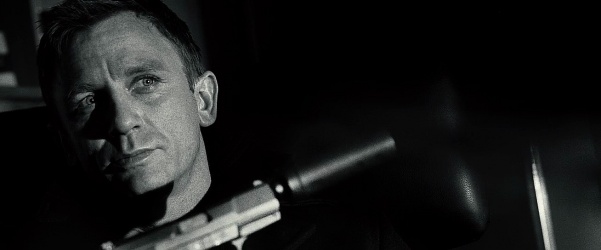
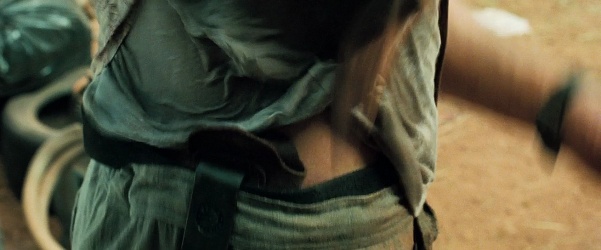
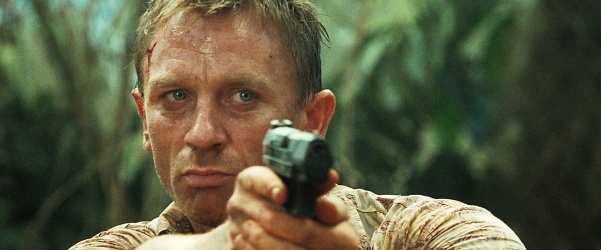
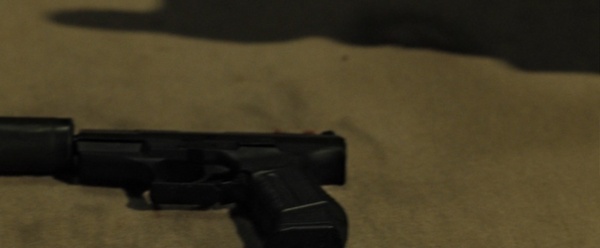

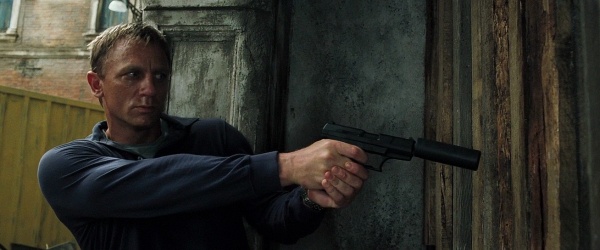

Bond
decocks and puts away his suppressed P99 in Dryden's office during the film's
opening.

Bond draws
his P99 from his Vega IB339 IWB holster.

Bond holds
his Walther on Mollaka.

Bond and
one of the terrorists, Steven Obanno (Isaach De Bankolé) struggle for the
suppressed P99.

Bond gives
his P99 a brass check after checking to make sure there's ammo in the magazine.

Bond fires
a suppressed P99 into the house in Venice.
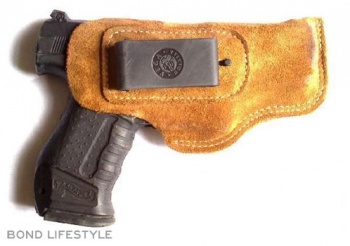
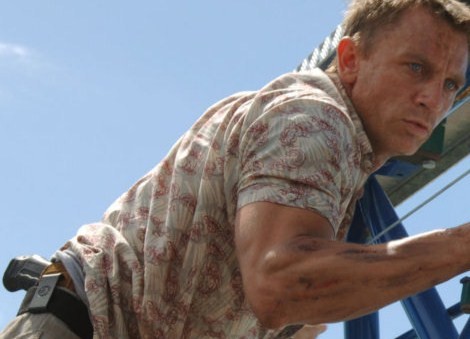
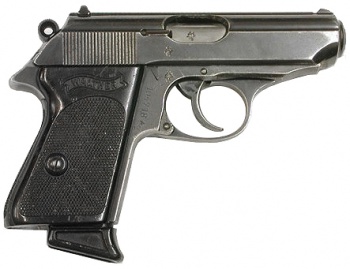
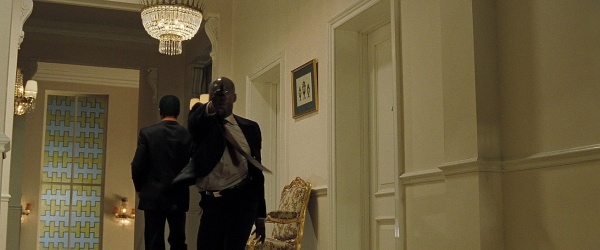

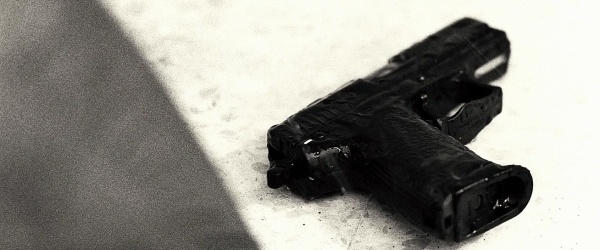
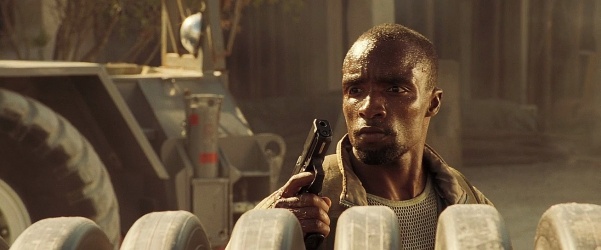
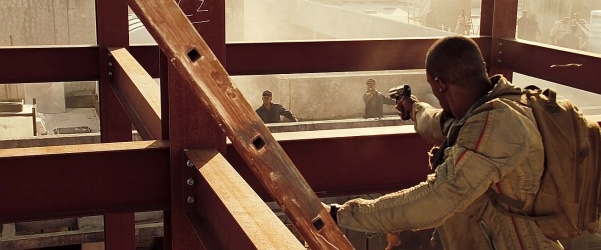
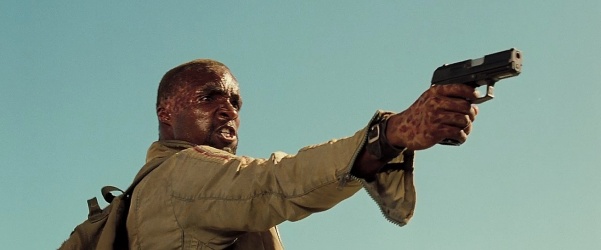

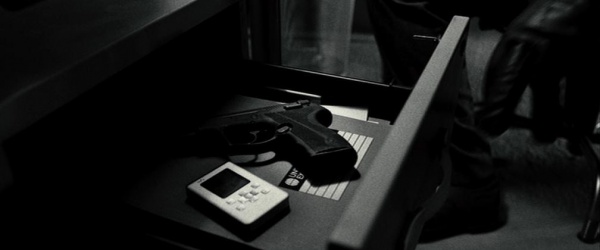
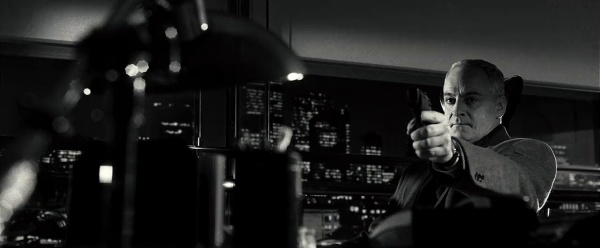

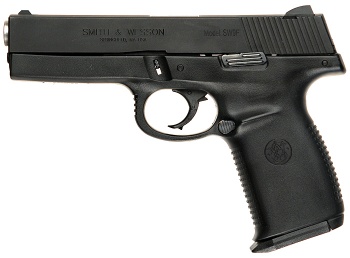

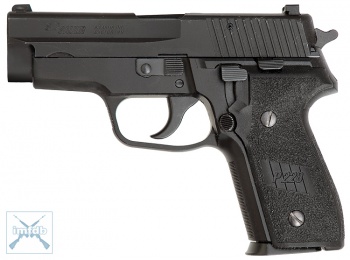
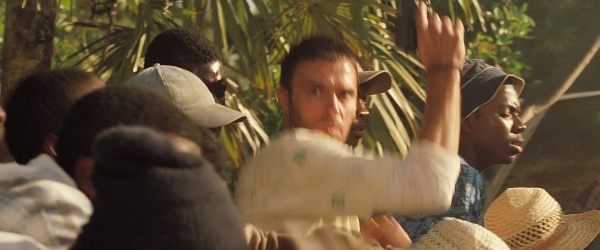
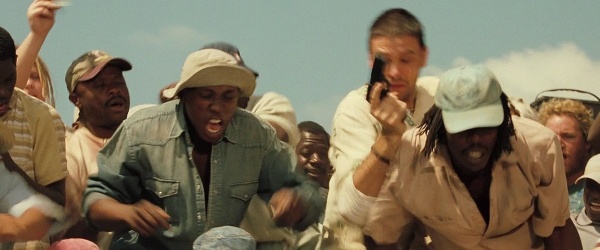
Rubber
Stunt Walther P99

Rubber
stunt PPK and Vega holster used in production.

Bond with
rubber stunt and Vega holster. The rough action sequences called for a flexible
rubber stunt to be used to avoid accidents on set.
Walther PPK

Walther PPK
- .32 ACP.


A Ugandan
terrorist fires at Bond and Vesper as they retreat into the staircase.

The
terrorist runs after Bond and Vesper as the other draws his sword.
Heckler
& Koch USP Compact
Section
Chief Dryden's underworld contact Agent Fisher (Doud Shah) has a Heckler &
Koch USP Compact. The bomb-maker Mollaka (Sébastien Foucan) also uses a USP
Compact, firing eight shots before running out of ammunition. It was suggested
that Mollaka might be using the .45 ACP model for this reason, however the bore
appears too small to be a .45 ACP pistol.

Heckler
& Koch USP Compact

Fisher's
USP Compact.

Mollaka
(Sébastien Foucan) draws his USP Compact.

Mollaka
shoots from the construction site. Note the spent shell mid-flight in front of
the beam to the right.

Mollaka
(Sébastien Foucan) pulls the trigger, not knowing his USP Compact was empty. In
real life, the slide would lock back to signal that it is empty, but to build
the drama and due to willing suspension of disbelief, you aren't supposed to
know it's empty until he dry-fires it at Bond.
Star
Ultrastar
Dryden
(Malcolm Sinclair), the MI6 Section Chief in Prague, uses a Star Ultrastar.

Star
Ultrastar 9mm with spare magazine

Dryden
opening his drawer to get his Star Ultrastar.

"Shame.
We barely got to know each other." Dryden (Malcolm Sinclair), the MI6
Section Chief in Prague, pulls a Star Ultrastar.
Taurus
PT92AF
Seen in the
opening credits, and can be distinguished from a Beretta 92FS by its frame
mounted safety.

Taurus
PT92AF - 9x19mm
Smith &
Wesson Sigma
One of Le
Chiffre's thugs keeps a Smith & Wesson Sigma in his waistband while the
money is being loaded into the SUV.

Smith &
Wesson Sigma SW9F - 9mm

The thug's
Sigma can be seen tucked into his waistband.
SIG-Sauer P228
SIG-Sauer P228
Carter (Joseph Millson), another MI6 agent in Nambutu with Bond, draws a SIG-Sauer P228 before beginning to chase Mollaka. A P228 is also seen in the opening credits.

SIG-Sauer
P228 - 9x19mm

Carter
draws his P228.

Carter
falls into the snake pit while holding his SIG. The rounded trigger guard helps
identify it as a P228.
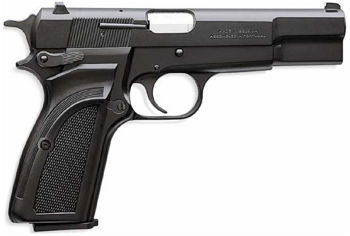
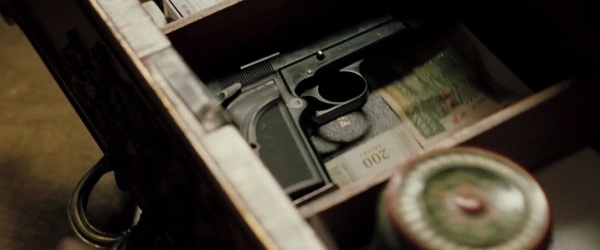
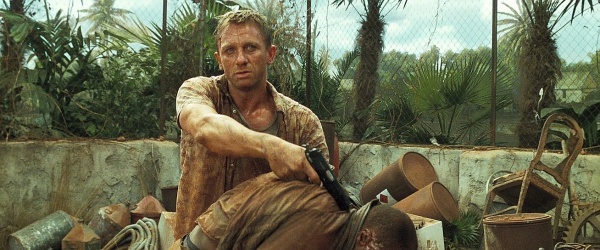

Browning
Hi-Power
The Nambutu
ambassador (Valentine Nonyela) keeps a Browning Hi-Power Mark III in his drawer
which Bond takes and uses to dispatch a few enemies. When the ambassador comes
down to confront him, Bond engages the safety, then drops it.

Commercial
Browning Hi Power Mark III - 9mm

The
Browning HP Mark III of the Nambutu ambassador

Bond holds
the Browning HP on Mollaka.

Bond
engages the Hi-Power's safety before dropping it.
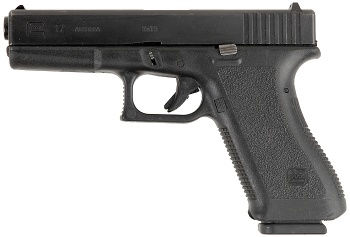

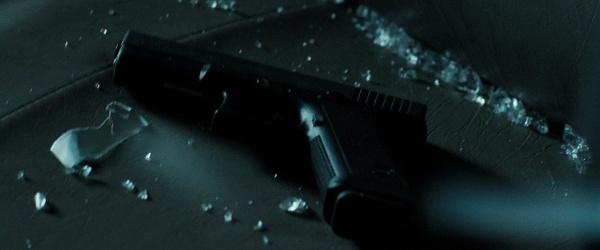
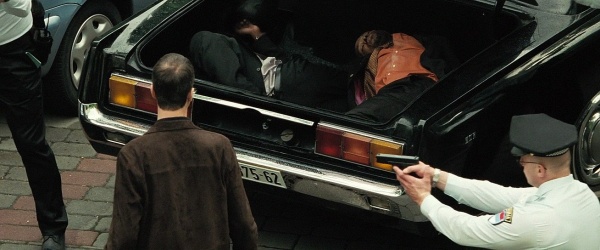
Glock 17
The
terrorist Carlos (Claudio Santamaria) uses a 2nd Generation Glock 17 as his
sidearm that he takes from the Miami airport security office. He fires it at
Bond during the pursuit at Miami Airport. Also used by the Montenegro police.

Generation
2 Glock 17 9mm

Carlos's
Glock 17 in the fuel truck's cab

The Glock
17 just before it is picked up and knocked out when Bond is kicked through the
truck's door.

The
Montenegro police draw Glocks on one of Le Chiffre's men after Mathis hides the
dead Ugandan terrorists in his trunk.
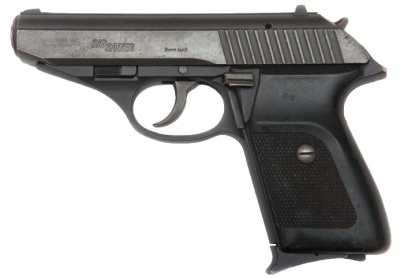
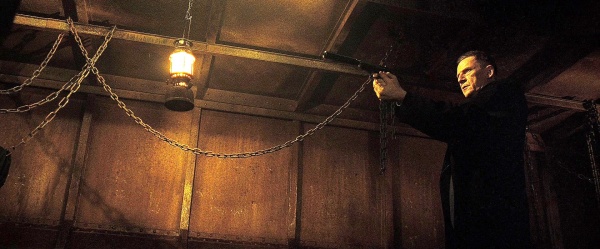
SIG-Sauer
P230
Mr. White
(Jesper Christensen) uses a suppressed SIG-Sauer P230 pistol near the end of
the film.

Blued
SIG-Sauer P230 - .380 ACP

Mr. White
fires the SIG.
SIG-Sauer P226
Gettler's
thugs use SIG-Sauer P226 pistols with suppressors. Also seen in the opening
credits.
SIG-Sauer
P226 9mm
One of
Gettler's thugs aims a suppressed P226.
Another of
Gettler's thugs aims a suppressed P226 at Bond before entering the house with
Gettler and Vesper.
Jericho 941
F
Gettler
(Richard Sammel) uses a two-tone Jericho 941 F (stainless frame and black
slide) during his battle against Bond. Also seen in the opening credits.
Jericho 941
F (two tone early model) - 9x19mm
Gettler
ducks from Bond's cover with his Jericho 941.
Gettler
aims his Jericho 941.
Gettler
holds his Jericho 941 inside the falling house.
Submachine
Guns
Heckler
& Koch UMP-45
There are
two appearances of UMPs in the film, the first seen are the Heckler & Koch
UMP-45s seen used by two of Gettler's thugs, both fitted with vertical grips
and suppressors, while one of them has an ACOG.
H&K UMP
.45 ACP
One of Gettler's
thugs fires a UMP-45 at Bond.
The other
thug fires a UMP-45 from the other window.
Gettler's
men fire at Bond with their suppressed Heckler & Koch UMP-45s.
Heckler
& Koch UMP-9
James Bond
(Daniel Craig) uses a suppressed Heckler & Koch UMP-9 to wound Mr. White's
leg towards the end.
Heckler
& Koch UMP9 9x19mm with suppressor
Bond with
his suppressed UMP-9.
"The
name's Bond. James Bond."
A movie
publicity still
Shotguns
Remington
870
Remington
870 shotguns are used by Miami airport police officers when they arrest Bond
after mistaking him for a terrorist.
Remington
870 Police Magnum Riot Shotgun - 12 gauge
Miami
police officers hold their Remington 870s on Bond while arresting him.
Rifles
AK rifles
Many of the
"freedom fighters" in Uganda in one of the early scenes carry AK
rifles and variants.
AKM,
Stamped Steel Receiver w/ slant muzzle brake - 7.62x39mm
Norinco
Type 56-1 (under-folding stock variant) - 7.62x39mm
Ugandan
terrorists holding AKs as Le Chiffre arrives in Uganda. The young boy can be
seen with an AKM and the man next to him with an Norinco Type 56-1
AK of
second model - 7.62x39mm (note stock mounting bracket)
An AK can
be spotted next to one of the briefcases of money.
SAR-3
The guards
of the Nambutu Embassy can be seen using what on close examination is
determined to be a Romanian SAR-3, a 5.56x45mm AK variant that looks similar to
the AK-47.
SAR-3 -
5.56x45mm.
Soldiers in
the Nambutu Embassy shoot at Bond with SAR-3 rifles.
The
ambassador walks past a soldier aiming a SAR-3 at Bond.
Colt Law
Enforcement Carbine
The police
at Miami Airport can be seen using Colt AR-15 Law Enforcement Carbines. They
are noted as such instead of M4A1 carbines because they have 16" barrels
instead of 14.5" barrels like an M4. This means they were converted to
full-auto for the film.
Colt Law
Enforcement Carbine (RO6920) - 5.56x45mm
A Miami
police officer aims at the tires of the gas tanker.
Another
Miami officer fires his Colt LE Carbine.
The same
Miami police officer falls back into the car with his Colt Carbine.
Other
Hispano-Suisa
M-55 20mm
It shows up
in the background of the same scene.
Watch more:
|
Casino Royale-2006
|
Quantum of Solace
|
Skyfall
|
|
|
|
|
|
|
|
Background
A quick quiz: of the five lead actors in EON's James Bond series, who played the most ruthless, cold-blooded version of 007?
Conventional wisdom points toward Timothy Dalton, with his chilling scene threatening Pushkin in The Living Daylights or his "You earnt it, you keep it," disposal of Killifer in Licence To Kill. Many votes would likely be cast for Sean Connery's "You've had your six," in Dr. No. There might even be a minority opinion for Roger Moore's "What a helpful chap." in The Spy Who Loved Me or the death of Locque in For Your Eyes Only.
But for sheer, consistent, cold-blooded body count, I'd like to nominate Pierce Brosnan as the Bond who gets the most use out of a licence to kill.
Review
Review
Brosnan nearly became James Bond in 1987. After playing Remington Steele on television for four years, Brosnan was picked to replace the aging Roger Moore in The Living Daylights. The news caused ratings for reruns of "Remington Steele," which had become so anemic that the series had not been renewed for the next season, to climb. On literally the last possible day, NBC exercised their option to renew the show and hold Brosnan to his contract to perform in it. They were apparently willing to arrange shooting schedules to accommodate the movie's needs; after all, they had renewed on the basis of having a TV show starring the Man Who Would Be Bond and it was in their interests to see that he was able to do the Bond film. Cubby Broccoli, however, is reported to have felt that audiences would be unwilling to pay to see a Bond they could see for free at home every week and Timothy Dalton was cast for The Living Daylights. After two films with Dalton, a six-year, litigation-filled hiatus in the series, Dalton's jumped-or-was-pushed decision not to return as 007 and a world-wide casting search that seems to have consisted largely of flipping through the "B's" in Cubby's rolodex, Pierce Brosnan was announced as the fifth actor to play James Bond for EON.
When Brosnan was first reported as having the role, prior to his replacement by Dalton, the perception was that he would play Bond in the light, rather comedic tradition of Roger Moore's portrayal. Brosnan was mostly known for "Remington Steele," which, though it had a modicum of action and suspense, was mainly a romantic comedy. Though Steele had the look and mannerisms of James Bond, the brains of the outfit belonged to Stephanie Zimbalist's Laura Holt character. Steele was mainly a parasitic front man. The entire premise of the series was the triumph of style over substance.
Just what the James Bond series needed after twelve years of Roger Moore in the lead role.
But by the time Brosnan actually got the keys to the Aston Martin "Remington Steele" was beginning to fade into memory. Brosnan had been in a series of theatrical and television movies in which he had shown a range extending from the comic foil in "Mrs. Doubtfire" to the cold and ruthless Soviet killer in "The Fourth Protocol." The Bond films had also had time to put the excesses of the Moore era behind them and the last two entries of the eighties had been considerably darker and more serious in tone.
Brosnan's Bond proved to be something more than a high-budget Remington Steele. With over thirty years of Bond films and four different actors having played the role, Brosnan had a wealth of examples on which to base his portrayal. Brosnan's Bond might best be described as Blended Bond. He combines a large portion of the serious, brooding, Flemingesque Bond of Dalton with the confident cockiness of Connery and just a dash of the well-tailored, upper-class style of Moore. Though he doesn't have Connery's powerful physical presence or Lazenby's cat-like grace in action scenes, he gave creditable performances in the climactic fight with Trevalyn and
 the short vicious skirmish in Carver's studio. He has carried on Dalton's intensity and introspection in scenes such as the beach conversation in GoldenEye and the brooding solitary drinking while waiting for the other shoe to drop in Tomorrow Never Dies. At the same time, he displays the cool wit of Moore and Connery in lines such as "First things first," and "Thousands. But I only pay them lip service."
the short vicious skirmish in Carver's studio. He has carried on Dalton's intensity and introspection in scenes such as the beach conversation in GoldenEye and the brooding solitary drinking while waiting for the other shoe to drop in Tomorrow Never Dies. At the same time, he displays the cool wit of Moore and Connery in lines such as "First things first," and "Thousands. But I only pay them lip service."
So what does that leave us with? Is Brosnan's Bond merely a homogenized version of what has gone before? Does he have anything of his own to contribute? After so many years and so many films, IS there anything distinctive, anything different, to be done with the role?
Well, yeah, sort of. As I said at the beginning, Brosnan has thus far shown us a more consistently ruthless, deadly James Bond than any of his predecessors. Other actors have had moments of chilling ruthlessness and they have often been among their most memorable scenes. But Brosnan's Bond, with his no-hesitation, no-wisecracks executions of Ourumov, Kaufman, Davidov and especially Elektra, has made the licence to kill more than just a cool-sounding trademark; it's a large part of who this James Bond is. Bond knifing the guard on the stealth ship and using his body to fool Stamper into believing Bond was dead was one of the most cold-blooded acts 007 has performed.
Along with that acknowledgement of who he is and what constitutes the essence of his profession comes a certain fatalism regarding his own life. It comes out in his response to Xenia's suggestion that he "enjoy it while you can," ("The very words I live by.") and M's reference to his "cavalier attitude toward life." When Bond answers Natalya's question about what makes him so cold by saying "It's what keeps me alive," and she responds "No, it's what keeps you alone," they're both right. These aspects of Bond's character, all of which have their roots in Fleming's writing, have become Brosnan's contribution to the screen portrayal of 007.
One unfortunate aspect of Brosnan's emphasis on Bond-as-professional-killer has been the ubiquity of machine guns in his films. While other Bonds have used them sparingly in the big battle scenes, Brosnan has gone into Rambo mode in all three films, mowing down hordes of extras single-handed. While it makes sense for Bond to use all the firepower he can get in those situations, it somehow seems inconsistent with the style Bond has had in the past. Firing one shot in each direction to confuse his pursuers into firing at each other while he slips off into the shadows is quintessential James Bond. Standing around like Machine Gun Kelly and killing a dozen guards whose only sin was coming to work that day lacks the proper panache. Bond is a killer but he shouldn't be portrayed as a butcher.
Brosnan's films have so far suffered from a tendency to sacrifice suspense and style for noise and firepower. There is reason to believe Brosnan recognizes this failing and is using his influence to push the films in other directions. The World Is Not Enough was a major improvement in terms of character development and plot over Tomorrow Never Dies. It remains to be seen whether Die Another Day continues that improvement. With luck, we may not have seen Pierce Brosnan's best Bond yet. What we have seen so far is promising.
Brosnan's films have so far suffered from a tendency to sacrifice suspense and style for noise and firepower. There is reason to believe Brosnan recognizes this failing and is using his influence to push the films in other directions. The World Is Not Enough was a major improvement in terms of character development and plot over Tomorrow Never Dies. It remains to be seen whether Die Another Day continues that improvement. With luck, we may not have seen Pierce Brosnan's best Bond yet. What we have seen so far is promising.
Watch More:
|
GoldenEye
|
Tomorrow Never Dies
|
|
The World Is Not Enough
|
Die Another Day
|
Background
Timothy Dalton: Best Bond Ever.

After Roger Moore's kitsch carry-on, 007 number four was a RADA-trained purist who played Ian Fleming's Cold War killer by the book.
Review
There's a beautiful moment at the end of Licence To Kill, the second and final of the short-lived Timothy Dalton Bond movies. After fleeing an exploding New Age meditation temple in a devastating four-rig truck chase, tumbling to the ground and setting fire to a petrol-soaked drug lord (Robert Davi), Dalton's 007 finally allows himself a breather. Smoke-blackened and scarred, he surveys the wreckage around him with a melancholic sigh. And then suddenly, and briefly, he shifts forwards and does a strangulated dry-retch. And that's when you get it. That's when, after umpteen glamorous, far-flung and babe- filled assignments, it finally hits home. James Bond's job makes him want to puke.
It was inevitable, of course, that the Dalton Bond would end right here, dry-retching in the desert in the summer of 1989. The movie was an outright flop at the American box office (taking only $32m), and didn't fare much better around the globe (the worldwide haul was a modest $156m). Fingers were pointed, naturally, at the film's strangely prurient depiction of torture (lots of mutilations), and at the subsequently dark avenger in Bond (he tosses pilots out of planes like so many high-altitude cigarette butts). The film was slapped with a moody 15 certificate in the UK, and though Dalton was contracted to make a third Bond movie, a timely ongoing "legal dispute" between film companies EON and UA/MGM resulted in a five-year delay between projects and the impatient actor eventually departed the franchise (of the split, the actor has simply said, "After that, I didn't want to do it any more").
And yet, surely this is only half the story. For Dalton was an Ian Fleming purist who was frequently surrounded by Bond novels on set, and who deliberately reconnected the franchise with its tough and often unflattering source material. Despite the spin that has emerged in recent years from Team Bond, especially Daniel Craig's Bond, about going back to Fleming for inspiration ("It's all about reading the books," said Craig, possibly tongue in cheek) no one can touch Dalton for genuine authenticity. Craig's Bond, for better or worse, is merely the incarnation of an interview that Fleming gave to the New Yorker in 1962, in which he nervously referred to Bond as "a blunt instrument" (Judi Dench's M uses the line in Casino Royale). The new, rebooted franchise has thus taken this trope at its most literal and transformed its Bond into a beefy no-neck killing machine with a capacity for moments of tenderness and reflection, but who's happier punching, kicking and thwacking, and running straight through plasterboard walls. Similarly, Pierce Brosnan's Bond was deeply indebted to the camp theatrics of Sir Roger Moore's Bond, which was a reaction, in turn, to Sir Sean Connery's grittier Bond which, when you think about it, wasn't that gritty at all (Little Nellie, the rocket-firing autogyro from You Only Live Twice; the Aston Martin with the ejector seat in Goldfinger; Connery quipping, "She had her kicks!" in Dr. No, as Rosa Klebb is shot after she attempts to kill him with a blade attached to her shoe, and so on).

The Living Daylights allows Dalton a single moment of kitsch in the opening scene, but then it's straight into Fleming territory as the dyspeptic, lonely hit man caught in a tangled love triangle.
Dalton's Bond, on the other hand, was an anomaly and a revelation when he first appeared in the summer of 1987 in The Living Daylights. The film allows him a single moment of kitsch in the opening scene (some business with a parachute and a bikini babe), but then it's straight into Fleming territory and to the depiction of a super-agent who owes nothing to movies, but has emerged directly from the author's canon and specifically from the short story of the same name. In the latter, Bond is a dyspeptic, tranquillizer-popping (he takes Tuinal) and hugely lonely hit man who's hoping, someday soon, to get fired. "With any luck it'll cost me my double-0 number," he says, when he hears that he's being reported to his seniors.
Dalton's Bond is dyspeptic too, and truculent ("Stuff my orders!"), and reluctantly caught in a tangled love triangle that involves him, his cellist lover Kara (Maryam d'Abo) and her Russian army boyfriend Georgi (Jeroen Krabbé), who is also a former Bond ally. The plot that unfolds, written by veteran Bond screenwriter Richard Maibaum and series producer Michael G Wilson, is ingenious, and moves from spy swaps in the Eastern bloc to arms dealing in Tangier to opium smuggling in Afghanistan with watertight assuredness. Plus, there is a modicum of gadget action, including a jet-propelled Aston Martin and an exploding key ring. Yet the film never once forgets character, and returns again and again to the melancholic Fleming Bond, whose sensitive relationship with d'Abo's Kara is the cornerstone of the film (and will later have echoes in Craig and Eva Green's relationship in Casino Royale). It helps, too, that Dalton is a powerhouse performer. The RADA-trained actor can do drugged with dignity ("I... Er. I... Chloral hydrate!"), while he's positively buoyant in some of his lighter scenes: "Are you calling me a horse's arse?" he chuckles at Kara. Equally, because of this sensitivity, the moments when he suddenly has to "become" the killer, are all the more shocking. "Get down on your knees. Put your hands behind your back," he says coldly to John Rhys-Davies' Russian general Pushkin, in an execution scene that might have been perfunctory for every other Bond, but here seems brutal and bleakly life defining.
And maybe that's the key to Dalton's Bond, and the reason why he drove it into the ground after just two instalments. Because the best moments of the modern movie Bonds show a professional agent trying to find his humanity in the midst of violence. Yet Dalton's portrait, just like Fleming's, was that of a man who is not finding his humanity, but losing it.
Watch More:
Menu
Roger George Moore

Review
There's a beautiful moment at the end of Licence To Kill, the second and final of the short-lived Timothy Dalton Bond movies. After fleeing an exploding New Age meditation temple in a devastating four-rig truck chase, tumbling to the ground and setting fire to a petrol-soaked drug lord (Robert Davi), Dalton's 007 finally allows himself a breather. Smoke-blackened and scarred, he surveys the wreckage around him with a melancholic sigh. And then suddenly, and briefly, he shifts forwards and does a strangulated dry-retch. And that's when you get it. That's when, after umpteen glamorous, far-flung and babe- filled assignments, it finally hits home. James Bond's job makes him want to puke.
And yet, surely this is only half the story. For Dalton was an Ian Fleming purist who was frequently surrounded by Bond novels on set, and who deliberately reconnected the franchise with its tough and often unflattering source material. Despite the spin that has emerged in recent years from Team Bond, especially Daniel Craig's Bond, about going back to Fleming for inspiration ("It's all about reading the books," said Craig, possibly tongue in cheek) no one can touch Dalton for genuine authenticity. Craig's Bond, for better or worse, is merely the incarnation of an interview that Fleming gave to the New Yorker in 1962, in which he nervously referred to Bond as "a blunt instrument" (Judi Dench's M uses the line in Casino Royale). The new, rebooted franchise has thus taken this trope at its most literal and transformed its Bond into a beefy no-neck killing machine with a capacity for moments of tenderness and reflection, but who's happier punching, kicking and thwacking, and running straight through plasterboard walls. Similarly, Pierce Brosnan's Bond was deeply indebted to the camp theatrics of Sir Roger Moore's Bond, which was a reaction, in turn, to Sir Sean Connery's grittier Bond which, when you think about it, wasn't that gritty at all (Little Nellie, the rocket-firing autogyro from You Only Live Twice; the Aston Martin with the ejector seat in Goldfinger; Connery quipping, "She had her kicks!" in Dr. No, as Rosa Klebb is shot after she attempts to kill him with a blade attached to her shoe, and so on).

The Living Daylights allows Dalton a single moment of kitsch in the opening scene, but then it's straight into Fleming territory as the dyspeptic, lonely hit man caught in a tangled love triangle.
Dalton's Bond, on the other hand, was an anomaly and a revelation when he first appeared in the summer of 1987 in The Living Daylights. The film allows him a single moment of kitsch in the opening scene (some business with a parachute and a bikini babe), but then it's straight into Fleming territory and to the depiction of a super-agent who owes nothing to movies, but has emerged directly from the author's canon and specifically from the short story of the same name. In the latter, Bond is a dyspeptic, tranquillizer-popping (he takes Tuinal) and hugely lonely hit man who's hoping, someday soon, to get fired. "With any luck it'll cost me my double-0 number," he says, when he hears that he's being reported to his seniors.
Dalton's Bond is dyspeptic too, and truculent ("Stuff my orders!"), and reluctantly caught in a tangled love triangle that involves him, his cellist lover Kara (Maryam d'Abo) and her Russian army boyfriend Georgi (Jeroen Krabbé), who is also a former Bond ally. The plot that unfolds, written by veteran Bond screenwriter Richard Maibaum and series producer Michael G Wilson, is ingenious, and moves from spy swaps in the Eastern bloc to arms dealing in Tangier to opium smuggling in Afghanistan with watertight assuredness. Plus, there is a modicum of gadget action, including a jet-propelled Aston Martin and an exploding key ring. Yet the film never once forgets character, and returns again and again to the melancholic Fleming Bond, whose sensitive relationship with d'Abo's Kara is the cornerstone of the film (and will later have echoes in Craig and Eva Green's relationship in Casino Royale). It helps, too, that Dalton is a powerhouse performer. The RADA-trained actor can do drugged with dignity ("I... Er. I... Chloral hydrate!"), while he's positively buoyant in some of his lighter scenes: "Are you calling me a horse's arse?" he chuckles at Kara. Equally, because of this sensitivity, the moments when he suddenly has to "become" the killer, are all the more shocking. "Get down on your knees. Put your hands behind your back," he says coldly to John Rhys-Davies' Russian general Pushkin, in an execution scene that might have been perfunctory for every other Bond, but here seems brutal and bleakly life defining.
Watch More:
|
The Living Daylights
|
Licence to Kill
|
Menu
|
|
|
|
|
|
|
Roger George Moore

Background
Following Sean Connery's departure from the Bond franchise, producers Albert Broccoli and Harry Saltzman turned to British TV star, Roger Moore, to fill those rather large shoes. While he was a star in England and American thanks to his six seasons on The Saint, Moore was roundly criticized even before his first Bond film as being too much of a lightweight to play the role.
Though it took a couple of movies, Moore actually settled into the part rather well despite continued calls that he had traded Connery's suave super agent for a campier version who was quicker with a wink than with his Walther PPK. Regardless, Moore spent 12 years in the role - longer than any other actor - and accounted for at least a few of the franchise's best films.
Review
Review
Live and Let Die-1973
Once Sean Connery left the franchise for good after Diamonds Are Forever (1971), Moore made his debut as James Bond in this blaxploitation-themed addition to the series. In Live and Let Die, Bond battles a Harlem drug lord named Dr. Kananga/Mr. Big (Yaphet Kotto), who plans on driving out the world’s drug cartels by flooding the streets with free heroin in order to gain a monopoly on the market. Not exactly the world domination plots from Bond movies of old, which makes Live and Let Die feel small in comparison. Despite criticism for the movie’s racial overtones and skepticism with Moore’s cheeky portrayal of 007, the film was a commercial hit, though it was a rather unimpressive debut.

The Man with the Golden Gun-1974
Outside of Moore’s last Bond movie, A View to a Kill, The Man with the Golden Gun was a true low point in the entire Bond franchise. And that’s putting it mildly. Here Bond faces off against Francisco Scaramanga (Christopher Lee), the titular villain who plots to acquire a super weapon called the Solex Agitator, which harnesses the power of the sun into a destructive weapon, while also seeking to assassinate Bond. Thinking he is Bond’s equal, Scaramanga was certainly one of the better Bond villains, thanks in large part to Lee’s convincing performance. But the film itself is long and slow – really, did we need to see Moore’s entire flight to Scaramanga’s hideout? – and boasts one of the silliest fight scenes, where Scaramanga’s dwarf henchman, Nick Nack (Herve Villechaize), tries to attack Bond with a knife and winds up being thrown into the ocean in a suitcase.

The Spy Who Loved Me-1977
After the disappointment of his first two films, Moore finally hit his stride in The Spy Who Loved Me, not only the best of the Roger Moore era, but one of the best movies in the entire series. This one has it all: a great opening ski chase that ends in a rousing parachute jump from a cliff that proudly displays the Union Jack; a stunningly beautiful Bond Girl, Anya Amasova (Barbara Bach), who goes by the code name Agent XXX; a classic Bond villain (Curt Jürgens) hell-bent on destroying the world; and everybody’s favorite indestructible henchman, Jaws (Richard Kiel), who uses overwhelming strength and reinforced steel teeth to overpower his victims. Sure, the campy humor is still there, but it’s measured well against the great action sequences and undeniable chemistry between Moore and Bach. The film was a massive hit with critics and audiences, and contained the one of the series’ most memorable theme songs, “Nobody Does It Better,” by Carly Simon.

Moonraker-1979
Most people dismiss Moonraker for its over-the-top action, absurd characters and all-too-campy humor. But it’s exactly because of those qualities that I love this movie and rank it high on my list of all-time best Bond movies. This time Bond battles madman billionaire, Hugo Drax (Michael Lonsdale), who builds a fleet of space shuttles and plans to use them to release poison gas across the globe, killing Earth’s entire population, before repopulating the planet with genetically perfect humans. Yes, Dr. Holly Goodhead (Lois Chiles) wasn’t the most exiting or glamorous Bond Girl, but Jaws makes his second and presumably last appearance, attacking Bond during a parachute dive and on a cable car, only to wind up helping 007 dispatch of Drax after he falls in love. Maybe the filmmakers went too far with Bond’s inflatable gondola, but Moonraker is still great fun and became one of the highest-grossing movies of the franchise.


The Man with the Golden Gun-1974
Outside of Moore’s last Bond movie, A View to a Kill, The Man with the Golden Gun was a true low point in the entire Bond franchise. And that’s putting it mildly. Here Bond faces off against Francisco Scaramanga (Christopher Lee), the titular villain who plots to acquire a super weapon called the Solex Agitator, which harnesses the power of the sun into a destructive weapon, while also seeking to assassinate Bond. Thinking he is Bond’s equal, Scaramanga was certainly one of the better Bond villains, thanks in large part to Lee’s convincing performance. But the film itself is long and slow – really, did we need to see Moore’s entire flight to Scaramanga’s hideout? – and boasts one of the silliest fight scenes, where Scaramanga’s dwarf henchman, Nick Nack (Herve Villechaize), tries to attack Bond with a knife and winds up being thrown into the ocean in a suitcase.

The Spy Who Loved Me-1977
After the disappointment of his first two films, Moore finally hit his stride in The Spy Who Loved Me, not only the best of the Roger Moore era, but one of the best movies in the entire series. This one has it all: a great opening ski chase that ends in a rousing parachute jump from a cliff that proudly displays the Union Jack; a stunningly beautiful Bond Girl, Anya Amasova (Barbara Bach), who goes by the code name Agent XXX; a classic Bond villain (Curt Jürgens) hell-bent on destroying the world; and everybody’s favorite indestructible henchman, Jaws (Richard Kiel), who uses overwhelming strength and reinforced steel teeth to overpower his victims. Sure, the campy humor is still there, but it’s measured well against the great action sequences and undeniable chemistry between Moore and Bach. The film was a massive hit with critics and audiences, and contained the one of the series’ most memorable theme songs, “Nobody Does It Better,” by Carly Simon.

Moonraker-1979
Most people dismiss Moonraker for its over-the-top action, absurd characters and all-too-campy humor. But it’s exactly because of those qualities that I love this movie and rank it high on my list of all-time best Bond movies. This time Bond battles madman billionaire, Hugo Drax (Michael Lonsdale), who builds a fleet of space shuttles and plans to use them to release poison gas across the globe, killing Earth’s entire population, before repopulating the planet with genetically perfect humans. Yes, Dr. Holly Goodhead (Lois Chiles) wasn’t the most exiting or glamorous Bond Girl, but Jaws makes his second and presumably last appearance, attacking Bond during a parachute dive and on a cable car, only to wind up helping 007 dispatch of Drax after he falls in love. Maybe the filmmakers went too far with Bond’s inflatable gondola, but Moonraker is still great fun and became one of the highest-grossing movies of the franchise.

For Your Eyes Only-1981
In an effort to tone down the over-the-top action and campy humor, the filmmakers returned to Bond’s espionage roots with For Your Eyes Only, a film that has divided critics and audiences since its 1981 release. Combining two Ian Fleming short stories, the film focused on Bond’s attempt to find a missile command system while becoming entwined with the vengeance-minded daughter (Carole Bouquet) of two marine archeologists murdered by a Cuban hitman. That leads to Greek smuggler Aristotle Kristatos (Julian Glover), who also wants to get his hands on the missile system. While there was plenty of camp in the opening sequence, where Bond turns the tables on a wheelchair-bound Blofeld, For Your Eyes Only does manage to stay within the lines. The action sequences are fantastic – especially the ski chase on the bobsled track – but the in-between moments are dull, while real-life figure skater, Lynn-Holly Johnson, makes for one of the most annoying Bond Girls ever.
Octopussy-1983
A return to the tongue-in-cheek tone of the previous Moore films, Octopussy again divided fans and critics despite being another big box office hit. By this point in his tenure, Moore was showing signs of his age, but he still managed to pull the off the role with his usual aplomb. Here Bond tries to uncover the death of British agent 009, who was found stabbed in the back while wearing a clown costume and holding a fake Fabergé egg. That leads 007 to uncovering a plot by Russian General Orlov (Steven Berkoff) and wealthy Afghan prince Kamal Kham (Louis Jordan) to detonate a nuclear weapon at a U.S. Army base in West Germany and forcing NATO to withdraw so the Soviet Union can invade. Along the way, he engages the titular Octopussy (Maud Adams), a wealthy businesswoman who leads a cult of female acrobats and helps Khan smuggle priceless jewels. Yes, it’s a bit much when Bond yells like Tarzan while swinging on vines through the jungle or convincing an attacking tiger to sit, but Octopussy is a fun movie and is not as bad as some people say.
A View to a Kill-1985
The last and definitely the worst Bond movie starring Roger Moore, which is saying something considering his first two efforts. Already past his prime in Octopussy, Moore – who was 57 at the time of filming A View to a Kill – had visibly aged since the last time fans saw him as 007, something even Moore himself acknowledged after the fact. Making matters worse was Bond girl Tanya Roberts, whose portrayal of Stacey Sutton was grating at best. Christopher Walken earned deserved kudos for playing psychopathic villain, Max Zorin, who plots to destroy Silicon Valley with an earthquake and gain a monopoly in the market. Both Moore and Walken criticized the movie for being too violent and over the top, while not adhering to the classic Bond mold.
Watch more:
|
Live and Let Die
|
The Man with the Golden Gun
|
The Spy Who Loved Me
|
|
Moonraker
|
For your eyes only
|
Octopussy
|
|
A View to a Kill
|
George Lazenby
as
Ian Fleming's
James Bond
Bond Dossier:
Born On:
September 5th, 1939
From:
Queanbeyan City, New South Wales, Australia
Eye Color:
Brown
Height:
6'2" (without shoes on)
Weight:
On Her Majesty's Secret Service (1969) 186 pounds
Played Bond In:
1. On Her Majesty's Secret Service (1969)
Box Office Gross: 1 Film:
$82 million ($381.3 million 2005 inflated)
Box Office Gross Per Film:
$82 million ($381.3 million 2005 inflated)
Bond Salary:
On Her Majesty's Secret Service (1969) J50,000 British pounds
*Turned down an offer of $1,000,000 from Bond co-producer Harry Saltzman and United Artists to star in Diamonds Are Forever (1971). Lazenby and his manager demanded a salary of $2,000,000 instead. Rather than pay Lazenby twice what they had offered him, Bond production company Eon signed Sean Connery instead for the base salary of $1.25 million. When Lazenby and his manager demanded twice the amount offered by Eon, Bond co-producer Cubby Broccoli refused to pay the sum and called it "outrageous".
*Turned down a 14 year, 7 Bond film/5 non-Bond film (12 film overall) contract with United Artists. The contract would have paid him $28 million for the 7 Bond films, and $5 million for the 5 non-Bond films. Lazenby's manager however demanded $35 million for the 7 Bond films, and Bond co-producer Cubby Broccoli refused to pay that much.
Lazenby Bond Trivia
Lazenby was offered a 7 Bond film contract from James Bond production company Eon before, during, and after filming of On Her Majesty's Secret Service. Despite the popular belief that he quit the role or that he was fired, he actually simply was in a lengthy contract disupute, of which his saying he had quit the role was part of his negotiating ploy. There was a lengthy dispute over Lazenby's Bond contract because it was 14 inches thick and covered everything from how Lazenby should behave in public, how he should dress, what car he should drive, how he should wear his hair, that he always be cleanly shaven, how he handle his personal life, where he should dine out, who he should be seen in public with, among numerous other things over the 14 year length of the contract. Lazenby felt he needed to be paid extra money in order to keep in line with such a Draconian contract for so many years. In the end, Lazenby turned down a very large amount of money and demanded twice what he was offered, and Bond production company Eon and United Artists then removed him from their plans in the Bond franchise.
Lazenby was offered a then huge actor's salary of $1 million to play 007 in Diamonds Are Forever by Bond co-producer Harry Saltzman and United Artists, but he demanded twice that amount and thus was never signed for the role.
Ever Wondered Why George Lazenby Only Made One James Bond Movie?
The question of how come George Lazenby only played 007 in one Bond film has long been one of those great movie trivia questions. There are many conflicting reports and stories on why George Lazenby was only in one 007 movie, and there seems to be a real dearth of the actual facts or story being printed in the press or known to most of the public as to why he only donned the famous Bond tuxedo and played the world's most famous film character just once.
The following is the true and complete account of why George Lazenby only made one James Bond film, a subject that has baffled many people for years, who have often wondered how a previously unknown model/actor from a small town in the outback of Australia could have been in his right mind to leave what was at the time the world's most coveted celebrity status position, and thus end up being known as the proverbial and quintessential one-hit wonder. The following article about Lazenby's Bond contract negotiations is based on the historical accounts by United Artists film studio and Eon Productions Company that detailed these particular events in question. (Lazenbyland note: We have had NO independent confirmation that any of this is true, but thought the article was at least worth reproducing here.)
Review
Why George Lazenby Didn't Have All The Time In The World?
It has often been reported that George Lazenby signed only a one film movie contract to make On Her Majesty's Secret Service, choosing to decline the 7 film contract that he was offered by Eon and United Artists. However this is in fact incorrect. In October of 1968, Lazenby turned down the 14 year/7 film contract that he had been offered and instead chose to sign a 7 year/4 film contract instead. Lazenby also agreed in this contract to sign a Legal Letter of Intent to play James Bond 007 in the James Bond film Diamonds Are Forever, which was to follow Lazenby's first 007 movie, 1969's On Her Majesty's Secret Service.
It should be noted that Lazenby felt he wasn't going to make another Bond film during the middle of On Her Majesty's Secret Service's production because he had grown extremely tired of the treatment he was receiving on all accounts. However this does not change the fact that he was still under contract, and that the Bond producers always thought he was going to make the next Bond film. The producers simply believed this was a ploy by Lazenby's managers to get him a better deal, which it in fact was. The fact that Lazenby already felt he was done at that point changes none of the below.
Also some of Lazenby's comments in interviews have been largely taken out of context to make it seem like he implied that he only was signed and obligated for one Bond film. That is absolutely wrong. Lazenby was only paid for one Bond film, with an additional first payment for his next Bond film. Meaning then, that because he had only been paid for one, that was the only one he had to make legally, providing he was not released from his contract. This has then been taken out of context and skewed by numerous media reports and "non-biased" interviewers as to mean he was only signed to a one picture deal, which is totally incorrect.
The 7 year/4 film contract that Lazenby signed was at industry minimum standard pay for a lead actor in films as big as the Bond films, with the built in industry pay increases for each successive film. This did not sit well with the Bond producers who wanted the young 28 year old Lazenby locked in to his contract for 7 films at the minimum pay rate they wanted him to get. Lazenby's managers however advised him that it would be better to sign a smaller contract at first, then re-negotiate his longer 7 film deal later on, so that he could demand more money for future films after he had already made some Bond films.
It has been widely reported that when Lazenby announced he was quitting the role of Bond during the filming of On Her Majesty's Secret Service that he indeed was only obligated contractually to make that film. But that is not accurate. Lazenby was in fact signed and obligated to make 4 Bond films over a 7 year period. During filming of On Her Majesty's Secret Service, the Bond producers constantly offered him the 7 film deal. Meaning he would then sign for 3 extra films in addition to the 4 that he had already signed on for. This offer to Lazenby was eventually extended to 7 Bond films after On Her Majesty's Secret Service, or 8 Bond films in total, and then finally to 7 Bond films after On Her Majesty's Secret Service, in addition to 5 non-Bond films made by United Artists. Lazenby wanted to sign the contract that included the 5 non-Bond films, but his personal manager told him not to.
It was announced to the press once again that Lazenby was leaving the role of Bond at the premiere of Secret Service. It was Lazenby's publicist that actually made the announcement. Lazenby also said he was leaving the 007 role while on an airing of The Tonight Show with Johnny Carson. By this point Bond producers Harry Saltzman and Cubby Broccoli were furious with Lazenby and did not know what to do with him. Contrary to popular belief, Lazenby was not free from his contract at this time. He was still obligated to make 3 more Bond movies. Also contrary to popular belief, Lazenby was not fired at this time. Instead the Bond producers decided to let Lazenby out of his Bond contract the day after the premiere of On Her Majesty's Secret Service.
The big dispute between Lazenby and Bond co-producer Cubby Broccoli was over the rules in Lazenby's contract. He actually could be fired for something as simple as not shaving every day while not even filming a Bond movie. There was even a clause in his contract that stated that he had to get his dinner guests approved by Cubby Broccoli before he could be seen dining out with them in public. There were numerous clauses of this nature in his contract and none of them sat well with Lazenby.
The Bond producers finally realized that they had to let Lazenby out of his contract because he was not going to behave as they wanted him to unless they did so. For example, Lazenby's wearing a beard and long hair in public, hanging out at nightclubs and bars, and saying he was quitting the role numerous times. This sort of thing was done by Lazenby so that he could get the 7 film deal he wanted, but minus all the Draconian rules it had contained within it. In order to do that he first had to get out of the original contract that he had signed.
Although Cubby Broccoli didn't want to take these clauses out of Lazenby's deal he realized he had no choice, so Saltzman and Broccoli released Lazenby from his deal. They then began negotiating with him on his new contract. The many reports that he was by this time officially no longer Bond are wrong. At this time Harry Saltzman and Lazenby negotiated with each other directly, minus Broccoli and Lazenby's managers. Saltzman had been given full power by United Artists and Broccoli to get Lazenby whatever deal he wanted as long as it stayed within the salary range they wanted to pay him. Lazenby would then take the offers to his manager for approval.
Saltzman then offered Lazenby a contract for 7 more Bond films and 5 non-Bond films minus all the Draconian clauses in the deal. However, the offer was still to start at the minimum industry standard pay with the same built in industry standard increases for each successive film. Lazenby and his now rather infamous top personal manager/publicist Ronan O'Rahilly, a well known British producer who created Radio Caroline, worked for The BBC and who also managed The Beatles for just one week's time (although some people say it was actually for just one day's time), turned that offer down. They countered it by asking for twice the pay rate offered, as well as Lazenby getting twice as big a dressing room, twice as big a limo, twice as big a trailer, twice as big a personal expense account with Eon, and also with a clause in the contract that stated that Lazenby would keep all the Saville Row suits, Rolex watches, and Bond cars used in his films.
Although Saltzman, and in particular United Artists, were willing to meet these demands, Cubby Broccoli was not. Broccoli insisted that since Sean Connery did not even get much of that treatment, it did not make sense to give it to Lazenby, even though he would essentially become the world's biggest movie star if he signed the deal. Broccoli remarked how Richard Burton had made similar demands from Eon and UA while he and Lazenby were the final two candidates for the Bond role, and that they wouldn't give Burton what he wanted. In Broccoli's mind he felt that George Lazenby was better for Bond than Burton, but he also felt that if Eon and UA weren't willing to give Burton the sort of perks that he had wanted, it would be foolish to give them to Lazenby. Broccoli therefore would not agree to Lazenby's demands.
Studio heads from United Artists then met with Saltzman and Broccoli in New York and instructed them to offer Lazenby a longer term deal, termed "a lifetime contract", in the hopes that this would entice him to take the money being offered, as it would ensure that Lazenby would be at the top of the movie business for many years. The thinking behind this was that Lazenby would take less money and perks than he was asking for if he had a guaranteed, extremely lucrative, and heralded gig for the rest of his career, and that this would then firmly establish in the public and press that Lazenby was Bond for life and that Connery, or no one else was going to be Bond.
Eon offered Lazenby 10 additional Bond movies, which would have given him a total of 11 Bond films in all. The contract was to cover a period of 20 years beginning in 1970 and ending in 1990. Lazenby's last Bond film was to be shot in 1988, and released in 1989. This film eventually became Licence To Kill starring Timothy Dalton, who in a strange twist of irony was actually offered the role of Bond in On Her Majesty's Secret Service before auditions for unknowns were held.
Cubby Broccoli felt that it was of absolute top priority that they establish in the minds of the press and the public that Bond was Lazenby's gig exclusively and that he be known entirely for Bond. In Broccoli's view, Eon could fully groom Lazenby for the Bond role since he was known simply for it and had not been a professional actor; and that by having everyone know Lazenby had a lifetime contract that would cover two whole decades, it would make the public not only change their mind's that only Connery was clearly Bond, but it would also eventually lead to Lazenby replacing Connery in the public's minds as the definitive Bond.
When Lazenby was offered this deal he was anxious to sign it, but he still had to get approval for it from his managers. This was because Lazenby had signed an agreement with his managers that they had to approve of all of his deals. He had signed this agreement just days after he had won the Bond casting. Lazenby felt that his biggest obstacle and hurdle in playing Bond was the public's belief that Bond was Connery's gig, so the lifetime contract was the perfect way for him to overcome that, since everyone would be told that he was signed for the next 20 years. This would stop any sentiment amongst the movie-going public that Connery could be brought back if people were hard on Lazenby and stayed away from his films at the box office.
When Lazenby showed the contract offer to his main manager, he was advised by him that Bond would not last that much longer past the early 1970's because it was no longer a viable character for the times. He advised Lazenby that the tuxedo-clad super-spy had become a cultural dinosaur that was out of touch with the realities of the popular hippie culture of the time. He also advised Lazenby that by signing this contract, he would become completely type cast in the Bond role and then find himself stuck in a star role that was no longer fit for the times, and one that would not enjoy even half the success that it had in the earlier 1960's Sean Connery era. Lazenby did not agree with this advice and wanted to sign the contract, but his managers would not approve of it, and because he had signed the agreement with them that he couldn't sign any deals without their approval, he could not accept the offer.
When Lazenby then had to turn this offer down, Harry Saltzman broke off contract talks and went back to United Artists along with Cubby Broccoli to discuss their options. At that point they first considered looking for a new Bond, and also offering a huge contract to Sean Connery. They then decided to sign American actor John Gavin to the Bond role as an insurance policy. Gavin's contract stated that if they could not get Lazenby or Connery signed in time to make the scheduled filming start of Diamonds Are Forever, that Gavin would then make the film. However, if either Connery or Lazenby could be re-signed to make the film, Gavin would then receive a one-time $500,000 severance pay, and no longer be attached to the role. UA and Eon could not simply delay the film because they already had sold some of the film's overseas profits to various investors, and if the film was delayed they could then be sued for that money.
UA and the Bond co-producers finally decided to simply offer Lazenby a film contract for Diamonds Are Forever at a salary of $1 million. Saltzman met Lazenby in London, in February of 1970, and offered him $1 million to make Diamonds Are Forever, and told him that after that film was completed that they could then either negotiate further films for Lazenby, or that if Lazenby wanted to then quit he could. Saltzman explained to Lazenby that they did not have time to cast another Bond, that it had cost them over $1 million just to cast him, and that they could not take on neither that task, nor cost again at the time. So Saltzman told Lazenby that, Eon needed enough time to prepare for Bond 007 actor casting again if it had to be done over. He also informed Lazenby that Eon/UA had to make the scheduled production start of Diamonds Are Forever, because if they did not, John Gavin would get the role, and they didn't want that to happen.
Lazenby was also willing to sign this deal. However when he brought it to his main personal manager he was told that the salary was not high enough. Although Lazenby just wanted to take the deal, he still had to get the approval from his managers. Lazenby was told to tell Saltzman that he would make just one more 007 film for a salary of $2 million, and that he would then not make any more Bond films after that. When Lazenby told this to Saltzman, he was informed that the producer had only been authorized to offer up to $1 million by his partners, and that he would have to discuss the $2 million demand with them.
Saltzman flew back to New York to meet with Broccoli and studio heads from United Artists to discuss his last meeting with Lazenby. When Saltzman informed them of Lazenby's final demand, Cubby Broccoli became outraged. Saltzman and UA were actually willing to pay the $2 million salary but Broccoli refused. He was particularly angry at Lazenby not only demanding such an astronomically huge salary at that time, but also the news that even if Lazenby got such a pay he would still not make another Bond film. The $1 million film salary that they were offering to Lazenby to star in Diamonds would have made him the highest paid male lead for base salary in movie history. Broccoli therefore felt that Lazenby's $2 million asking price was simply an out of line demand, especially considering Lazenby would not commit to more than one more film.
It was then that United Artists decided that Lazenby was out of consideration for the Bond role. United Artists executive David V. Picker, then ordered Saltzman and Broccoli to re-sign Sean Connery at any cost. They offered Connery a then huge base salary of $1.25 million, as well as 12.5 percent of the film's net US profits, extra pay for the film going over the set shooting schedule, and also funding for Connery to produce and star in 3 film projects of his own choosing.
This was seen as the biggest deal ever for an actor for a single film to that point. In the end, Connery ended up earning a reported $6 million total for Diamonds Are Forever (three times the amount Lazenby had asked for), and he donated his entire $1.25 million base salary that he earned from the film to the Scotish International Educational Trust, which Connery co-founded. Only one of Connery's 3 non-Bond films allocated in the deal was actually produced, and Connery claimed that Bond co-producer Cubby Broccoli never paid him the $4.75 million of the film's profits that he was owed, although there was never any legal verification or ruling that was true. Connery signed the deal just days after Lazenby's handlers had made their final salary demands. Gavin was paid his $500,000 contract buyout by United Artists.
Lazenby, for having signed a Legal Letter of Intent to star as 007 in Diamonds, had been given an early initial payment of his salary for that film prior to the time that Connery had been officially signed to return the Bond role. Under the agreement in Lazenby's Legal Letter of Intent, if he did not star as James Bond in Diamonds Are Forever, he would have to reimburse Eon for the initial payment he had received for the film. Lazenby reimbursed Eon for this money after Connery signed.
Watch More:
On Her Majesty's Secret Service
|
Background
With roguish charm and cool sophistication, Sean Connery inaugurated the long-running James Bond franchise with 1962’s Dr. No and remained the prototypical 007 among fans for decades despite five (and counting) other actors tackling the role.
Author Ian Fleming initially disagreed, and denounced Connery as an unrefined and overgrown stuntman. But he changed his tune after seeing Dr. No and even inserted Scottish heritage into Bond’s background in subsequent novels.
Connery’s Bond movies laid the foundation for what became a standard formula throughout the franchise: elaborate stunts, high-tech gadgets, exotic locales, catchy one-liners and, of course, sexy and often outrageously named Bond Girls. But it was Connery himself who defined the role and set in stone the archetype for all others to follow.
Review
Review
Dr. No-1962
In 1962, the movie-going world was introduced to James Bond, a British secret agent with a devil-may-care attitude and license to kill, and with it the success of the spy movie in the 1960s was born. In this first film, Bond is sent to Jamaica to investigate the death of a fellow British agent, only to encounter deadly assassins, a sexy femme fatale and even a poisonous tarantula. With the help of CIA agent Felix Leiter and the bikini-clad Honey Rider - who makes an unforgettable entrance - Bond searches for the headquarters of the fanatical Dr. No, a Chinese scientist bent on world domination. Made on a low budget, Dr. No was a big box office hit and laid the cornerstone for what would become the most successful film franchise in history.
From Russia with Love-1963
Connery returned for this second installment to the series and toned down 007’s ruthlessness from Dr. No in favor of a suave and sophisticated demeanor. This time, Bond is tasked with reclaiming a decoder device stolen by the evil SPECTRE organization, which contains Russian state secrets and threatens to unbalance to world order. He travels to Istanbul, where he confronts the cunning assassin Red Grant (Robert Shaw), whose preferred method of killing is a garotte wire hidden inside his wristwatch, and the dour Rosa Klebb, who wears deadly poisoned-tipped shoes. From Russia with Love received a bigger budget, thanks to the success of Dr. No, and helped solidify Connery’s standing as the definitive Bond. The film ranks high in comparison to the other installments, with some considering to be the best of the franchise.
Undeniably the gold standard of Bond films, Goldfinger set forth the template for all other 007 pictures: theme song sung by a popular artist, a focus on high-tech gadgets – in this case an Aston Martin complete with ejector seat – and a maniacal arch-villain who spouts campy one-liners while devising Rube Goldberg-like methods of trying to kill Bond. That’s not to say any of this is bad; Goldfinger is a wildly entertaining movie that introduced a lethal hat-throwing henchman named Oddjob and the suspiciously named Pussy Galore. It was a clear departure from the first two films and set the stage for increasingly flashier productions, setting the precedent that each subsequent film had to surpass its predecessor.
Goldfinger-1964
Undeniably the gold standard of Bond films, Goldfinger set forth the template for all other 007 pictures: theme song sung by a popular artist, a focus on high-tech gadgets – in this case an Aston Martin complete with ejector seat – and a maniacal arch-villain who spouts campy one-liners while devising Rube Goldberg-like methods of trying to kill Bond. That’s not to say any of this is bad; Goldfinger is a wildly entertaining movie that introduced a lethal hat-throwing henchman named Oddjob and the suspiciously named Pussy Galore. It was a clear departure from the first two films and set the stage for increasingly flashier productions, setting the precedent that each subsequent film had to surpass its predecessor.
Thunderball-1965
Originally intended to be the first Bond film, Thunderball was embroiled in a legal battle involving Fleming’s former screenwriting collaborators Kevin McClory and Jack Wittingham, who settled out of court and received executive producer credits. Bond again takes on SPECTRE, which steals nuclear war heads, buries them deep in the ocean and demands a £100,000,000 ransom while threatening nuclear disaster. Jaunting to the Bahamas, Bond battles evil mastermind Emilio Largo, while vying for the attention of three beauties: British agent Paula Caplan, Largo’s mistress Domino Derval and SPECTRE agent Fiona Volpe. A step down from Goldfinger, Thunderball nonetheless has been held in high regard by fans since its successful release.
You Only Live Twice-1967
While on location in Japan, Connery publicly announced that he would be retiring from the role after five movies. In the film, Bond takes on the head of SPECTRE, Ernst Stavro Blofeld (Donald Pleasance), in an effort to prevent a world war after a mysterious rocket ship seizes manned space missions from Earth’s orbit. For the first time, Blofeld’s face was revealed on screen – only his hands and back of his head were seen in From Russia with Love and Thunderball – while the movie continued the trend of shifting away from the real-world espionage of the earlier movies toward the campy world-domination plots that defined the Roger Moore era.
Diamonds are Forever-1971
After George Lazenby made his only appearance as Bond in On Her Majesty’s Secret Service, Connery stepped back into the role for what would be his last appearance as 007 for over a decade. Lazenby declined a return to the series, which left producers Albert Broccoli and Harry Saltzman to search for another actor. In the end, they paid Connery an unprecedented $1.2 million to reclaim his role; this time, Bond disguises himself as a diamond smuggler to uncover a plot by old foe, Blofeld, to build a giant laser. Globetrotting through Las Vegas, Amsterdam and Germany, and featuring the aptly named Plenty O’Toole, Diamonds Are Forever was a box office hit, but ranked as one of the campier Connery efforts, thanks to a rather silly chase involving a moon buggy through the Nevada desert.
Never Say Never Again-1983
In 1971, Connery famously said that he would never play Bond again. Fast-forward 12 years and he agreed to return for one final performance. Never Say Never Again was the only Bond film not produced by Broccoli and Saltzman’s Eon Productions; instead, it was written and produced by Kevin McClory, who managed to retain rights to Fleming’s novel, Thunderball, after a lengthy legal battle. Essentially a remake of Thunderball, the movie saw an aging Bond brought out of retirement to do battle with megalomaniacal millionaire Maximillian Largo, who steals several nuclear warheads in order to bring the world to its knees. The film opened mere months after Roger Moore’s Octapussy, and set a record for the best opening for a Bond film. It also was a return to form for Connery after the silliness of Diamonds Are Forever, and allowed him to depart the character on a high note.
Watch more:
Watch more:
|
Dr. No
|
From Russia with Love
|
Goldfinger
|
|
Thunderball
|
You Only Live Twice
|
Diamonds are Forever
|
|
Never Say Never Again
Background
Before the first real Bond movie began filming,
Ian Fleming stated to EON productions (the group that has produced the
“official” Bond movies) that he preferred David Niven to Sean Connery. Alas, it was not to
be for Sir David and the part went to the
Scotsman. However, in 1967, Niven had the last laugh, playing James Bond
in a parody version of the spy films. Five, count them, FIVE directors
worked to make this erratic mess of a psychedelic comedy. Along with
Niven you have John Huston, William Holden, Peter Sellers, Orson Welles, Ursula
Andress (a Bond girl!), Woody Allen and Charles Boyer hamming up the
screen. The plot barely makes sense, but somewhere in there is the bare
bones of arms deals and gambling and…I can’t begin to describe the weirdness of
this film, but maybe the trailer will give you an idea.
Charles
K. Feldman, the producer, had acquired the film rights and had attempted to
get Casino Royale made as an Eon Productions Bond
film; however, Feldman and the producers of the Eon series, Albert R. Broccoli and Harry
Saltzman, failed to come to terms. Believing that he could not compete with the
Eon series, Feldman resolved to produce the film as a satire.
The
film has had a generally negative reception among critics, some of whom regard
it as a baffling, disorganised affair, with critic Roger
Ebert branding it "possibly the most indulgent film ever made".
On the other hand, Andrea LeVasseur called it "a psychedelic, absurd
masterpiece"and cinema historian Robert von Dassanowsky has
described it as "a film of momentary vision, collaboration, adaption,
pastiche, and accident. It is the anti-auteur work of all time, a film shaped
by the very zeitgeist it took on."
I
just recently watched the 1967 version of "CASINO ROYALE". You know .
. . it's not as bad as many critics and Bond fans make it out to be. In fact,
it was not difficult at all for me to follow the plot. The only time when the
movie actually gets confusing is near the end, during the big battle at the
casino. And even that seems like a spoof of those major battles at the end of a
Bond movie that were becoming the norm by 1966/67 (for example, the Fort Knox
battle at GF and the underwater battle in TB). Even DN had its scene of chaos
and mass destruction, when Dr. No's lair was being destroyed. I noticed
something else rather curious - just as in the 2006 version, Le Chiffre had
attempted another means to raise money before facing Evelyn Tremble (aka James
Bond) at the baccarat table.
The
humor and wit was sharp and David Niven had one of the best lines ever in a
Bond movie - "The spy was a member of a select and immaculate priesthood,
vocationally d-devoted, sublimely disinterested. Hardly a description of that
sexual acrobat who leaves a t-trail of beautiful dead women like blown roses
behind him.". Watching Peter Sellers' Tremble trying to be a suave super
spy was hilarious. Ursula Andress made an interesting Vesper Lynd. And Burt
Bacharach's score was absolutely delicious. I suspect that many viewers may
have been so distracted by the sight gags and jokes that they failed to realize
that the plot to CR '67 may not have been as confusing as one might think.
Review
Double-barreled shotgun
While hunting in Scotland, Sir James
Bond (David Niven) fires a side-by-side shotgun, reloading it several times and
using it to shoot down the bombs disguised as birds aiming for him.
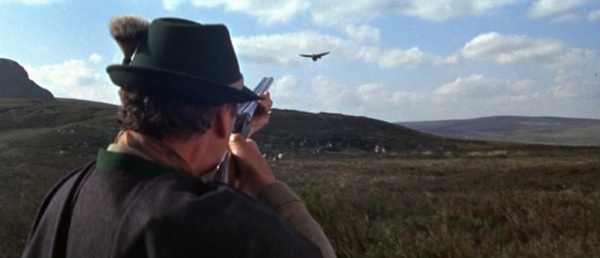
Bond aims for one of the bombs.

Bond fires his shotgun.
Luger P08 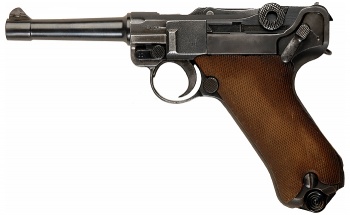 Luger P08 9x19mm 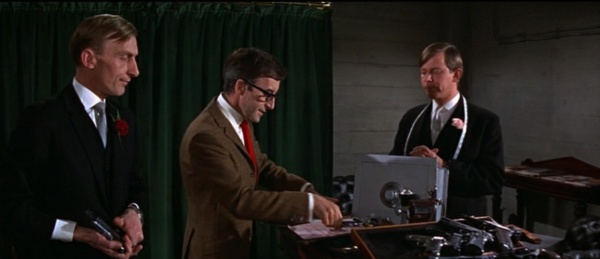
A Luger sits in the case on the far
right of the weapons.
Walther P38 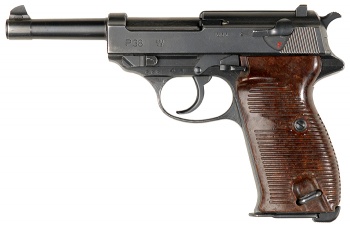
Walther P38 - 9mm
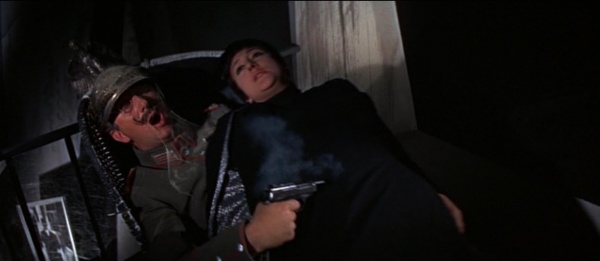
The dead German officer fires his P38.
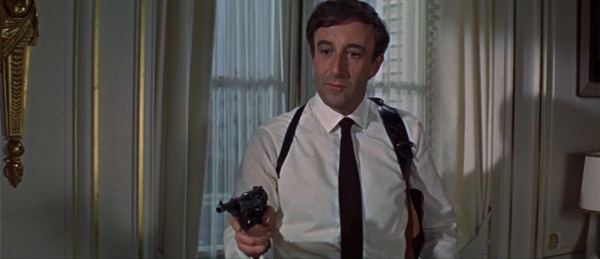
Evelyn Tremble (Peter Sellers) with his
P38.
Unidentified revolvers
One of Le Chiffre's men (Vladek Sheybal,
who also starred in the official Bond film From Russia With Love as Kronsteen,
four years earlier) and two thugs during the finale fire revolvers.
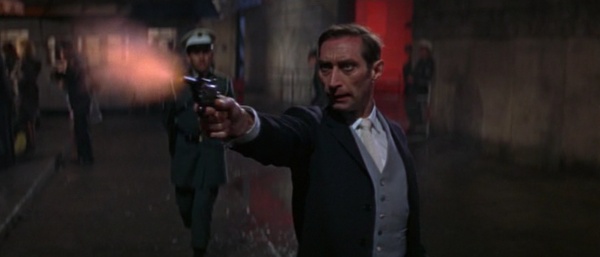
Le Chiffre's man fires his revolver at
Mata Bond.
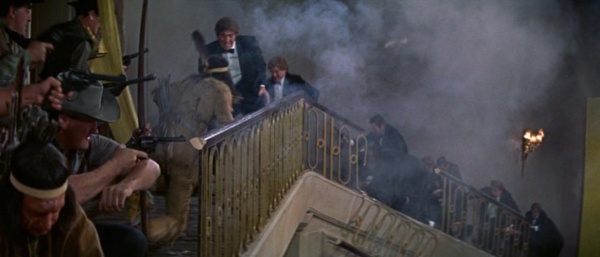
Two thugs fire their revolvers during
the finale.
These appear to be Smith & Wesson
M1917's.
Colt M1911A1
Several thugs are also seen with M1911A1
pistols.
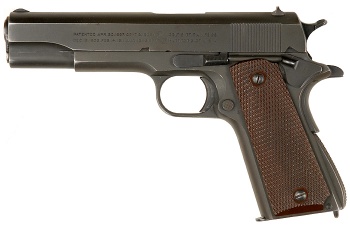
M1911A1 - .45 ACP.
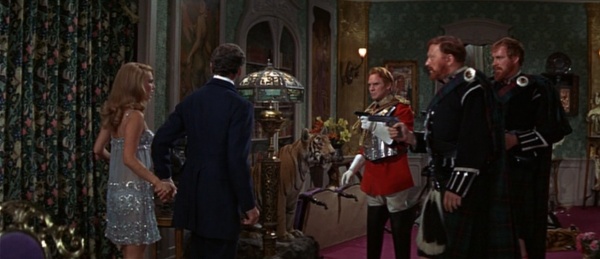
A thug holds Bond and Moneypenny at
gunpoint with his 1911.

Vesper's thug holds an M1911A1 on Bond.
Sterling L2A3 SMG
James Bond (David Niven) grabs a
Sterling SMG, using it while facing Dr. Noah's guards until he is disarmed by
Dr. Noah/Jimmy Bond (Woody Allen). Dr. Noah's female assassins all have
Sterlings as well.

Sterling Submachine Gun - 9mm
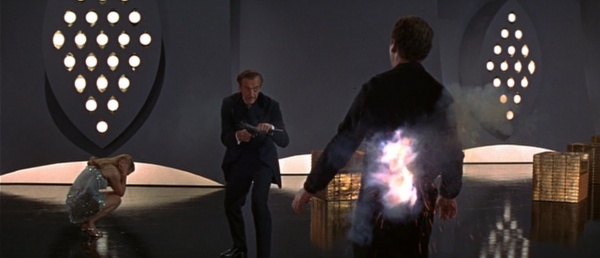
Bond shoots a double of himself.
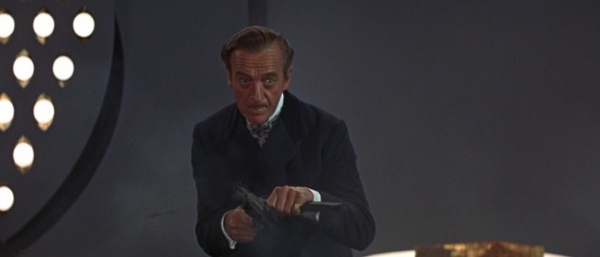
Bond firing the Sterling.

Bond covers his face, Sterling in hand.
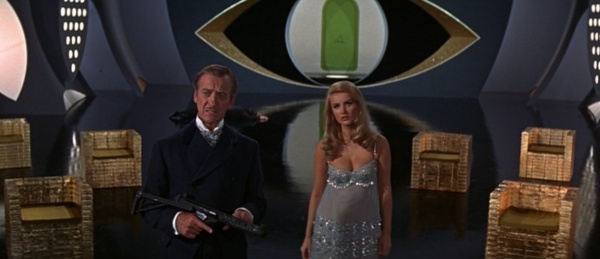
Bond and Miss Moneypenny (Barbara
Bouchet) discover Dr. Noah's true identity.
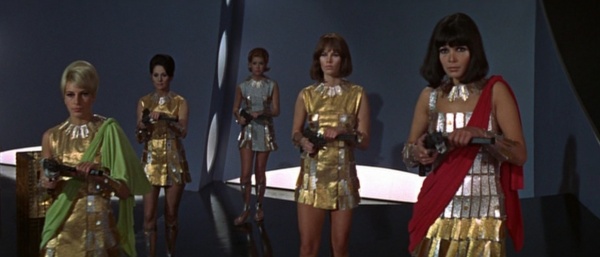
Dr. Noah's women approach Bond with
Sterlings.
Scottish bagpipes shooting
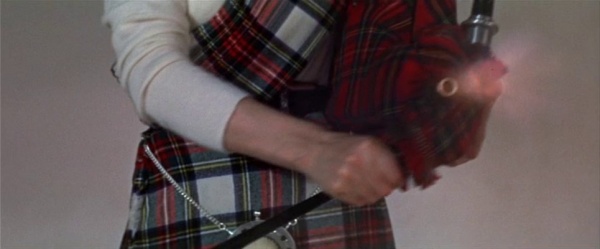 
Vesper Lynd (Ursula Andress) used
unidentified submachine gun hidden in the Scottish bagpipes.
Beretta M1934

Beretta Model 1934 Stainless, - .380
ACP.
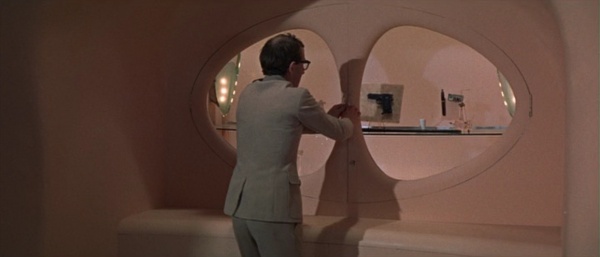
Dr. Noah goes towards his Beretta M1934.
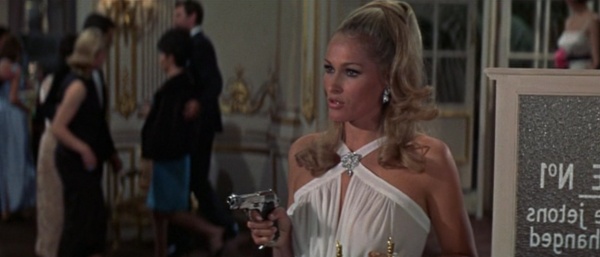
Vesper holds her nickel M1934 on Bond.

George Raft with the M1934.
Mauser C96

Mauser C96 "Broomhandle"
Commercial - 7.63x25mm Mauser.
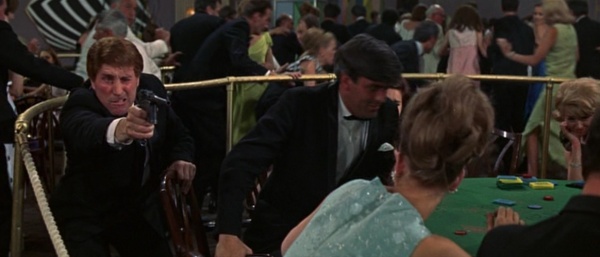
The hitman aims at Bond.
Winchester Model 1873

Winchester Model 1873 carbine - 1st
generation rifle - 44-40 WCF.
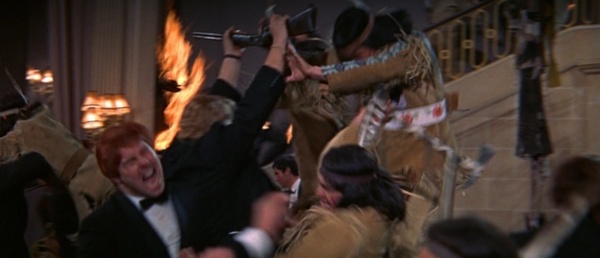
An Indian and a thug fight over a
Winchester '73 during the finale fight scene.
Colt New Service
One of the Americans fires a Colt New
Service during the final fight scene inside Casino Royale.

Colt New Service M1917 in moon clipped
.45 ACP.

Americans fire a Webley and Colt New
Service during the finale.
Webley Mk VI
Strangely, one of the American cowboys
fires a Webley Mk VI during the final fight scene inside Casino Royale.

Webley Mk VI .455 Webley

Americans fire a Webley and Colt New
Service during the finale.
Background
Contrary to popular belief, the honour of being the first actor to play James Bond fell not on Sean Connery, but on American Barry Nelson, who starred in a live one-hour production of Ian Fleming's Casino Royale. The performance on 21st October 1954 (8.30pm EST) was the first in CBS's 'Climax' series of dramas. CBS brought the rights for Fleming's first book for $1000. Nelson played James Bond as an American named "card sense" Jimmy Bond; the program also featured Peter Lorre as the primary villain. Originally broadcast live, the production was believed lost to time until a kinescope emerged in the 1980s. It was subsequently released to home video, and is currently available on DVD as a bonus feature with the 1967 film adaptation of the novel.
During production Nelson was unaware of the fact that the character of Bond was an Englishman. In an exclusive interview with Cinema Retro in 2004, he said “At that time, no one had ever heard of James Bond….I was scratching my head wondering how to play it. I hadn’t read the book or anything like that because it wasn’t well known. The worst part of it was that I learned it was to be done live. I thought I was finished with live t.v. I was trying to get out of it, actually".
Fleming's novel had only just been published in America six months before the TV production (it was first published on 13th April 1953 in the UK), and the screenplay was developed late on. “They were making changes up to the last minute. There was nothing you could do if anything went wrong”, Nelson said.
Whilst he enjoyed acting opposite Peter Lorre (Le Chiffre) and Linda Christian (Vesper Lynd), he was frustrated by the fact that time constraints had eliminated any background information about the character of Bond. Nelson recalled “I was very conscious of the fact that there wasn’t much to go on. It was too superficial.”
“Casino Royale” made little impact on audiences or critics and was largely dismissed as just another “run of the mill” edition of “Climax!”. Over the next few years, however, Fleming’s Bond novels began to grow in popularity and by the early 1960’s they had established an enthusiastic following throughout the world.
Review Casino Royale-1954
Jimmy Bond arrives at the Casino Royale in Monte Carlo, Monaco but is shot at whilst entering. He meets up with British Secret Service secret agent Clarence Leiter (this character was called Felix Leiter in the original Ian Fleming novel). He briefs Bond about his mission then Bond runs into old flame Valerie Mathis (she is an amalgam of the Vesper Lynd and Rene Mathis characters from the novel). She introduces him to Le Chiffre who is the Chief Soviet Agent in the area and is nearly always accompanied by three henchman called Basil, Zoltan and Zuroff. Le Chiffre has been gambling with the Soviet funds of his employers and he's down several million francs. Bond's mission is to beat him at a high-stakes card game of Baccarat so Le Chiffre will be ruined.
Watch More:
Casino Royale-1954
©Copyright AHD Productions, 2013.
|







